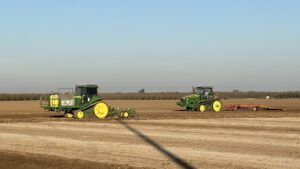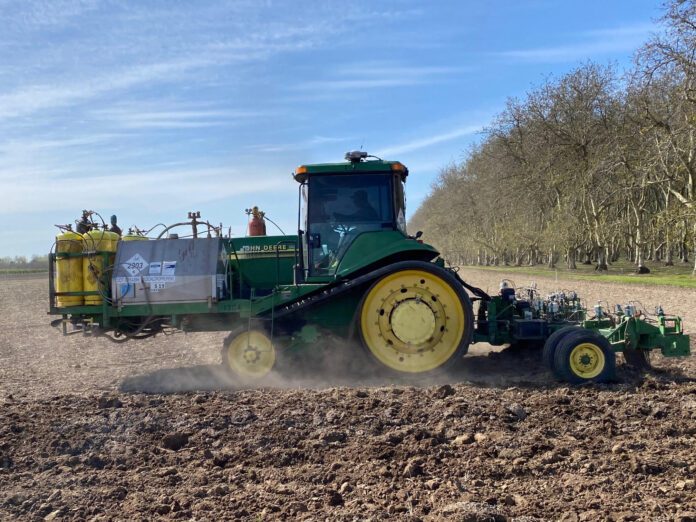One year after California Department of Pesticide Regulation introduced a proposal to further restrict use of the valuable soil fumigant Telone (1,3-dichloropropene), a new revised rule goes into effect January 1, 2024.
The DPR states the 2024 rule will reduce human health risks from agricultural fumigation operations. The state’s reasoning for the added restrictions is based on their formula that assumes a person remains in one location for multiple years (70 years, to be exact) and is being continuously exposed to the fumigant.
The new rules will increase costs and make applications more complicated, said Mike Stanghellini, director of research for the fumigation company Tri-Cal. Trial work in perennial crops takes a few years to really know the net effects on tree health, he added.
Setbacks from occupied structures are expanded, application rates and total treated acreage are limited under the new rules. There are also new requirements for lower emission application methods for use in tree and vine crops, which DPR reports have the highest application rates for Telone.
The new regulations will require the use of totally impermeable film (TIF) or alternative means of emissions reduction, including deeper soil injections.
One of the biggest challenges will be the new soil moisture requirements. Stanghellini said growers will have to decide if they want to use rainfall in the winter months when setbacks are higher or spend money on supplemental irrigation to prepare the soil to DPR’s new moisture requirement for fumigation. To meet the new moisture requirement for 100 acres, three acre-inches per acre, or a total of 8.15 million gallons, of water must be applied before a fumigation operation. There are also questions about the efficacy of the fumigant in higher soil moisture levels.

These new rules, which were proposed by DPR in 2022, will mainly impact walnut growers’ efforts to manage root lesion nematode (Pratylenchus vulnus), a primary plant parasitic nematode that affects walnut trees. This soilborne pest infests 85% of California walnut acreage according to the Walnut Scion and Rootstock Improvement Working Group. Within a single season, root lesion nematode can reach damage thresholds, and within two years can result in 20% reduction of tree growth. Root damage by root lesion nematode results in lower yields, limb dieback in trees of bearing age and root stunting in replant sites which can kill young trees.
To reduce fugitive emissions of the fumigant, soil moisture at 50% of field capacity at the 3- to 9-inch depth is now required for a Telone application. Soil moisture at that level has been projected to be less effective in controlling root lesion nematode. Deeper injection of the fumigant and limits on the acreage for an application are also required. Stanghellini said when the DPR proposals were made last year, it was noted that applying an effective dose of the fumigant over a large area in a timely manner will be complicated. Applicators may be able to break up larger application sites into smaller blocks, but that would mean additional trips to the site, and added labor and fuel costs. Tarping costs are increased, including the installation cost and disposal cost.
Tarp availability is presently good, but Stanghellini said it will depend on national and global resin markets. Tarping costs now range from $600 per acre for only where tree rows will be (strip tarped) or up to $1500 an acre for a broadcast tarp fumigation. Tarping also has the added expense of glue and labor. Growers can opt to make deeper injections.
Blending Telone with the fumigant chloropicrin, which is effective against fungi as well as nematodes, is one strategy being considered for preplant fumigation. Stanghellini said field trials of blends have achieved results similar to Telone-only applications, but chloropicrin also comes with additional regulatory restrictions from Cal-EPA. Chloropicrin is currently under reevaluation at DPR, which is a comprehensive regulatory review similar to what the U.S. EPA completed in 2008.
More Water Needed
Josh Rahm, director of technical and regulatory affairs for California Walnut Board and Commission, said allocation of water for fumigation will require a decision by walnut growers looking to fumigate an orchard site prior to planting.
“In a drought year or with the Sustainable Groundwater Management Act, that will place further constraints. They have to choose not to reallocate water for fumigation or wait for rain,” Rahm said. “Walnuts are sensitive to root lesion nematode, and there are no viable products with the same efficacy of this fumigant. This new rule will affect decisions to plant new orchards. Even more concerning, it is not clear what effects such soil moisture levels may have on efficacy of treatments. Most likely efficacy in suppressing nematodes will be reduced, as previous research has identified levels that are required for efficacious treatments.”
There are not a lot of new orchards being planted due to market conditions, Rahm noted, but at some point, when new orchards are developed, there will be a need for an effective tool against nematodes.
Andreas Westphal, associate CE specialist/associate nematologist at UC Riverside, said alternatives to Telone and other fumigants are being field tested but are not yet registered for use in California. One fumigant alternative, Dominus, is no longer considered a biopesticide and is now considered a conventional pesticide by the U.S. EPA. The other, Salibro, is a postplant treatment while Dominus is a preplant product.
Neonicotinoid Restrictions
Effective January 1, neonicotinoid pesticides used in walnut and almond production are now limited due to concerns with pollinator health. The new DPR regulations apply to soil and foliar applications of products containing clothianidin, dinotefuran, imidacloprid and thiamethoxam. Soil application of products containing these active ingredients is now banned. Application of these products is prohibited during bloom, the period from the onset of flowering to petal fall. If both soil and foliar application methods are used at the same site, or if multiple neonicotinoid active ingredients are applied, the total maximum combined application rate must not exceed 0.2 pounds per season.
Walnut growers use two of these targeted insecticides, clothianidin and imidacloprid, against aphids and walnut husk fly with minor use against scale. DPR has estimated cost and application of alternative active ingredients would increase crop protection costs. Clothianidin is the only neonicotinoid registered for use in almonds, mainly targeting leaffooted bugs, stink bugs and San Jose scale.
Pistachios and pecans are exempt from the regulations.

Cecilia Parsons | Associate Editor
Cecilia Parsons has lived in the Central Valley community of Ducor since 1976, covering agriculture for numerous agricultural publications over the years. She has found and nurtured many wonderful and helpful contacts in the ag community, including the UCCE advisors, allowing for news coverage that focuses on the basics of food production.
She is always on the search for new ag topics that can help growers and processors in the San Joaquin Valley improve their bottom line.
In her free time, Cecilia rides her horse, Holly in ranch versatility shows and raises registered Shetland sheep which she exhibits at county and state fairs during the summer.
















